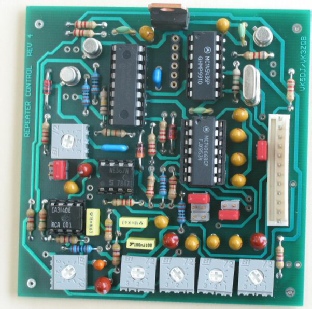

J.F.Drew © 2000-2017






Mobile menus
VK5DJ
Repeater controller features

Features a minimum of components and cost to achieve the following features:
- Two carrier-operated switch inputs (i.e. a receiver A and receiver B) either +ve or –ve going and programmable at ‘burn’ time.
- Two PTT outputs (any combination of low or high active programmed at ‘burn’ time.)
- Programmable delay for mute opening to overcome transient interference.
- Onboard DTMF decoder (jumpered to either receiver - may use an external receiver with no COS facility)
- Onboard CTCSS decoder (to meet licensing conditions or remove interference on main TX or link)
- Timeout timer
- Callsign generator with timer
- Short message morse beacon if required.
- Two adjustable tails - one before the beep and one after.
- Tail with mode pips (high pitch and low pitch depending on receiver)
- Remote inhibit of timer (two methods)
- Remote inhibit of primary repeater
- Remote inhibit of gateway (or link)
- Remote control of CTCSS requirement on primary or secondary
- Remote control of 'roger' beeps (inhibit or allow)
- Remote callsign change
- Remote adjustment of callsign delay (1 to 75 minutes in 1 minute increments)
- Remote adjustment of timeout period (0 to 75 minutes in 1 min increments)
- Remote adjustment of extended CTCSS operation
- Remote adjustment to support either a link or a gateway
- Remote adjustment of morse code speed (very slow to approx 35 wpm) and tone
- Remote adjustment of COS trigger (delay opening up to 255msecs)
- Remote adjustment of tail length (tail adjustable in 0.1sec increments from 0 - 15 seconds).
- Remote adjustment of secondary tail length (after the beep) from 0-15 seconds.
- Remote enable and timing of a regular CW message (never, or 1-75 minutes in 1 minute increments).
- Remote change of the morse message
- Remote decision on whether to pass DTMF tones through and DTMF may be received from any of three receivers (external, rptr, link)
- By retuning the CTCSS decoder the controller can be programmed to use 1750 tone "beep" access.
- AC Fail indication if a small board modification is made.
- LEDs to indicate power on, DTMF decoded, CTCSS decoded, PTT main, PTT secondary
- PIC16F1827 version 7.05 now includes a remoteable switch for external device control
- Version 7.06 now supports a voice ID using a cheap module from the internet. (See here)
- Version 7.07 fixes a minor issue in extended tail, adds remote reset to factory defaults and remote read version
- Version 7.08 added more control of the roger beeps. Added choice of ramped tone or single tone.
- Version 7.09 separated the mute delays so link rcvr delay can now be set independently from main rcvr
- Version 7.10 provides fan control on pin 16 (1-70 minutes after transmission)
I no longer have boards available.
On the supply of a 16F1827 the author will burn the PIC for amateurs at no cost other than return P/P
French language translation of an older version manual thanks to Patrick TK5EP see Downloads page.
General operation of the linking controller:
The controller enables a conventional duplex repeater to be controlled by a COS line from a receiver(s). The various timers and tones for operator information are provided.
It uses DTMF tones for remote control (password protected) and has facility for CTCSS control.
In addition it provides either a gateway or linking port (software determined). When configured as a gateway the secondary port has identification and a tail with telltail beeps if required.
The controller has a beacon function for club information.
There is a choice of five identification modes to match European and some local Australian requirements.
| Repeater features |
| Solar version |
| 1750Hz decoder |
| Record and playback |
| Voice interface |
| Micor solution |
| Yagi Calculator |
| RD Contest logger |
| Moon Tracking |
| Orbitron interface |
| PRFCalc |
| TAIT programming |
| Proton Development Suite |
| Old crystals for radios |
| Compound interest |
| Yagi photos |
| Bird proofing |
| Bender |
| VK5DJ downloads |
| VK3UM downloads |
| Site map |